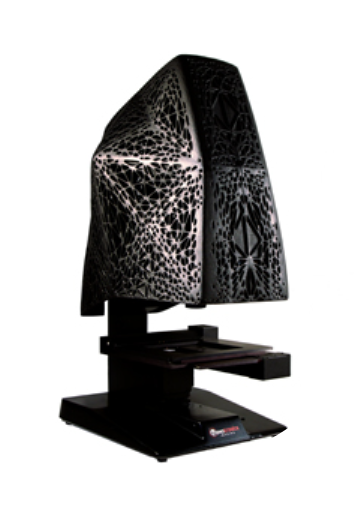
The nSpec 3D features 3D printed construction along with its high tech imaging technology. Courtesy of Nanotronics Imaging.
Latest News
October 15, 2014
New technology will always find a place in the workshops of progressive entrepreneurs. In the case of additive manufacturing (AM), that place has generally been in the workshops and labs or companies involved in aerospace, automotive, or medical. Other industries have been working with AM as well, and sometimes the results can be surprising.
Nanotronics Imaging may not be the type of company one might normally associate with 3D printing. The company designs and produces computer-controlled microscopes able to view down to nanoscale. Rather than just using AM for prototyping, the company may be the first laboratory equipment provider to offer a 3D printed microscope.
 The nSpec 3D features 3D printed construction along with its high tech imaging technology. Courtesy of Nanotronics Imaging.
The nSpec 3D features 3D printed construction along with its high tech imaging technology. Courtesy of Nanotronics Imaging.According to Nanotronics’ website, the new nSpec 3D is “an automated, rapid optical microscope that provides surface topographies and quantitative roughness measurements.”
The microscope has been designed to offer industries such as tire, medical device, steel, battery, aerospace and automotive a new method of inspecting for quality by using high quality optics to capture topography at the nano level. The system has been designed for ease of use as well as for quality results, including features that allow users to begin a scan with the touch of a button, according to the company.
“Our solution will allow a host of industries, including industrial materials, semiconductors, and even biopharmaceuticals, to access sophisticated imaging that can improve their ability to produce and manipulate advanced materials quickly and efficiently,” said Nanotronics Imaging CEO Matthew Putman.
All of that is very impressive, and probably in ways this editor doesn’t quite grasp, but what caught Rapid Ready Tech’s attention wasn’t solely the capabilities of the microscope, but how it was produced. Nanotronics called in New York designers Mari Kussman and Francis Bitonti, who developed a 3D printed casing that is both aesthetically pleasing and functionally robust.
The case is a perfect example of the strengths of AM, namely freedom of design, and the potential for weight reduction without sacrificing durability. As AM continues to evolve and production speed catches up with traditional methods of manufacturing, it seems reasonable to assume we’ll see more 3D printed products offered by an increasing number of different businesses.
Below you’ll find a video about Nanotronics Imaging.
Sources: Nanotronics Imaging, AZoNano
Subscribe to our FREE magazine, FREE email newsletters or both!
Latest News
About the Author
John NewmanJohn Newman is a Digital Engineering contributor who focuses on 3D printing. Contact him via [email protected] and read his posts on Rapid Ready Technology.
Follow DE





